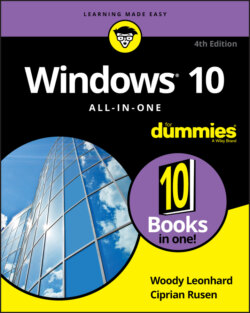Читать книгу Windows 10 All-in-One For Dummies - Ciprian Adrian Rusen, Woody Leonhard - Страница 77
Choosing 32 Bit versus 64 Bit
ОглавлениеIf you’ve settled on, oh, Windows 10 as your operating system of choice, you aren’t off the hook yet. You need to decide whether you want the 32-bit flavor or the 64-bit flavor of Windows 10 Home. Similarly, Windows 10 Pro and Enterprise are available in a 32-bit model and a 64-bit model.
Although the 32-bit and 64-bit flavors of Windows look and act the same on the surface, down in the bowels of Windows, they work quite differently. Which should you get? The question no doubt seems a bit esoteric, but just about every new PC nowadays uses the 64-bit version of Windows 10 for good reasons:
Performance: The 32-bit flavor of Windows — the flavor that everyone was using a few years ago— has a limit on the amount of memory that Windows can use. Give or take a nip here and a tuck there, 32-bit Windows machines can see, at most, 3.4 or 3.5 gigabytes (GB) of memory. You can stick 4GB of memory into your computer, but in the 32-bit world, anything beyond 3.5GB is simply out of reach. It just sits there, unused. That’s why you see 32-bit Windows only on tiny, cheap tablets and mobile devices. The 64-bit flavor of Windows opens your computer’s memory, so Windows can see and use more than 4GB — much more, in fact. With many desktop apps, such as the Google Chrome browser, acting like resource hogs, you'll want 4GB or more on any PC. Although lots of technical mumbo jumbo is involved, the simple fact is that programs are getting too big, and Windows as we know it is running out of room. Although Windows 10 can fake it by shuffling data on and off your hard drive, doing so slows your computer significantly.
Security: Security is one more good reason for running a 64-bit flavor of Windows. Microsoft enforced strict security constraints on drivers that support hardware in 64-bit machines — constraints that just couldn’t be enforced in the older, more lax (and more compatible!) 32-bit environment.
And that leads to the primary problem with 64-bit Windows: drivers. Some people have older hardware that doesn’t work in any 64-bit flavor of Windows. Their hardware isn’t supported. Hardware manufacturers sometimes decide that it isn’t worth the money to build a solid 64-bit savvy driver, to make the old hardware work with the new operating system. You, as a customer, get the short end of the stick.
Application programs are a different story altogether. The 64-bit version of Office 2010 was notorious for causing all sorts of headaches. You were better off running 32-bit Office 2010, even on a 64-bit system (yes, 32-bit programs run just fine on a 64-bit system, by and large). Office 2016 and 2019 don’t have the 64-bit shakes; they work fine on either 32-bit or 64-bit Windows. Some programs can’t take advantage of the 64-bit breathing room. It's not all sweetness and light.
Now that you know the pros and cons, you have one more thing to take into consideration: What does your PC support? To run 64-bit Windows 10, your computer must support 64-bit operations. If you bought your computer any time after 2005 or so, you’re fine — virtually all the PCs sold since then can handle 64-bit. But if you have an older PC, here’s an easy way to see whether your current computer can handle 64 bits: Go to Steve Gibson’s SecurAble site, at www.grc.com/securable.htm. Follow the instructions to download and run the SecurAble program. If your computer can handle 64-bit operations, SecurAble tells you.
If you have older hardware — printers, scanners, USB modems, and the like — that you want to use with your Windows 10 computer, do yourself a favor and stick with 32-bit Windows. It’s unlikely that you’ll start feeling the constraints of 32 bits until your current PC is long past its prime. On the other hand, if you’re starting with completely new hardware — or hardware that you bought in the past five or six years — and you plan to run your current PC for a long, long time, 64-bit Windows makes lots of sense. You may end up cursing me when an obscure driver goes bump in the night. But in the long run, you’ll be better prepared for the future.
